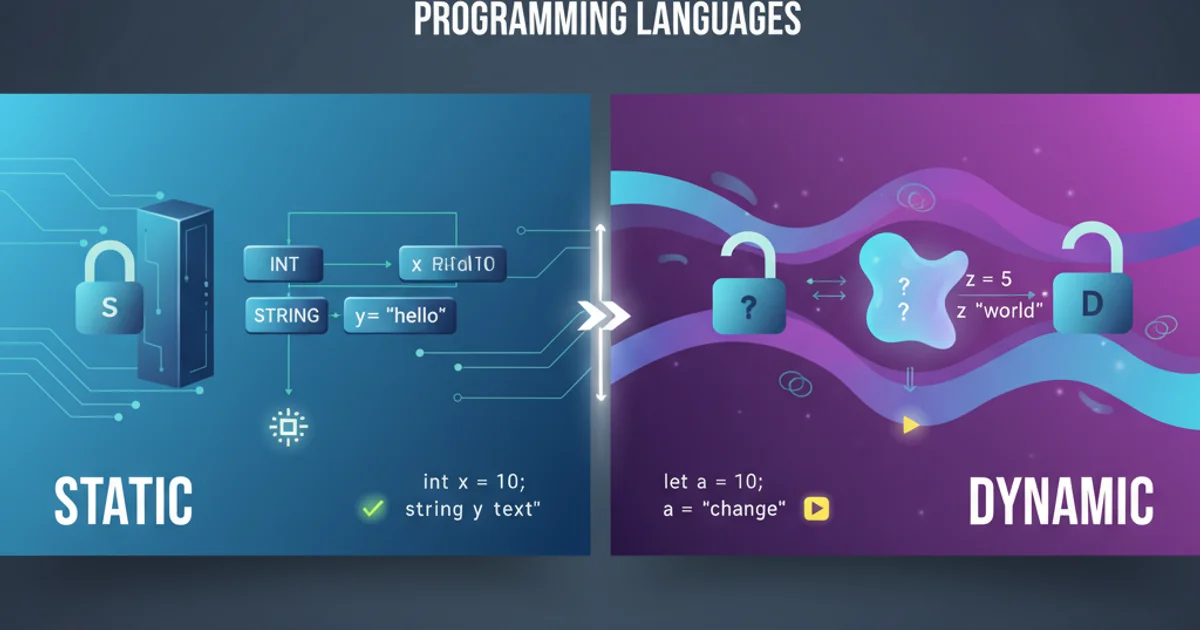Difference between static and dynamic programming languages
Categories:
Static vs. Dynamic Programming Languages: Understanding the Core Differences

Explore the fundamental distinctions between static and dynamic programming languages, their impact on development, and how to choose the right one for your project.
In the vast landscape of programming, languages are often categorized by how they handle type checking: either at compile-time (static) or at runtime (dynamic). This fundamental difference profoundly influences a language's characteristics, including performance, error detection, development speed, and flexibility. Understanding these distinctions is crucial for developers to make informed decisions when selecting tools for their projects.
Static Programming Languages: Rigor and Reliability
Static programming languages perform type checking during the compilation phase, before the code is executed. This means that the type of every variable, parameter, and return value must be explicitly declared or can be inferred by the compiler. If there's a type mismatch or an operation is attempted on an incompatible type, the compiler will flag it as an error, preventing the program from even starting. Examples include Java, C++, C#, Go, and Rust.
public class StaticExample {
public static void main(String[] args) {
int age = 30; // Type 'int' declared
String name = "Alice"; // Type 'String' declared
// age = name; // This line would cause a compile-time error: incompatible types
System.out.println("Name: " + name + ", Age: " + age);
}
}
A Java example demonstrating explicit type declaration and a commented-out compile-time error.
Dynamic Programming Languages: Flexibility and Rapid Development
Dynamic programming languages perform type checking at runtime, during the execution of the program. This means that variables do not have a fixed type associated with them; instead, their type is determined by the value they hold at any given moment. This offers greater flexibility, allowing for quicker prototyping and more concise code. However, type-related errors might only surface when the specific problematic code path is executed. Popular dynamic languages include Python, JavaScript, Ruby, PHP, and Perl.
def dynamic_example():
data = 10 # data is an integer
print(f"Data type: {type(data)}, Value: {data}")
data = "hello" # data is now a string
print(f"Data type: {type(data)}, Value: {data}")
# This would cause a runtime error if executed with a non-numeric 'data'
# result = data + 5
dynamic_example()
A Python example showing a variable changing its type at runtime.
Key Differences and Their Implications
The choice between static and dynamic typing often boils down to a trade-off between early error detection and runtime flexibility. Each approach has its strengths and weaknesses, impacting various aspects of software development.
flowchart LR
A[Programming Language] --> B{Type Checking Timing?}
B -->|Compile-time| C[Static Typing]
B -->|Runtime| D[Dynamic Typing]
C --> C1[Early Error Detection]
C --> C2[Improved Performance]
C --> C3[Better Tooling Support]
C --> C4[Steeper Learning Curve (sometimes)]
D --> D1[Rapid Prototyping]
D --> D2[Greater Flexibility]
D --> D3[More Concise Code]
D --> D4[Runtime Errors (potential)]
C1 & C2 & C3 --> E[High Reliability, Scalability]
D1 & D2 & D3 --> F[Agile Development, Scripting]
E --> G[Suitable for Large, Complex Systems]
F --> H[Suitable for Web Development, Data Science, Automation]
style C fill:#e0ffe0,stroke:#3c3
style D fill:#fff0e0,stroke:#c93Flowchart illustrating the core differences and implications of static vs. dynamic typing.
Error Detection
Static languages catch type errors during compilation, preventing a whole class of bugs from ever reaching runtime. This leads to more robust code, especially in large projects. Dynamic languages, conversely, defer type checking to runtime, meaning a type error might only appear when a specific code path is executed, potentially in production.
Performance
Generally, static languages tend to offer better performance. Since types are known at compile-time, compilers can perform optimizations that are not possible in dynamic languages, where type information is only available during execution. This often results in faster execution speeds.
Development Speed and Flexibility
Dynamic languages often allow for faster initial development and prototyping due to their less rigid structure. Developers can write code more quickly without needing to declare types explicitly. This flexibility can be a double-edged sword, as it can also lead to harder-to-debug issues in larger codebases. Static languages, while requiring more upfront declaration, can lead to easier refactoring and maintenance in the long run due to the compiler's assistance.
Tooling and Refactoring
Static typing provides rich information to IDEs and other development tools, enabling powerful features like intelligent autocomplete, accurate refactoring, and comprehensive static analysis. This makes navigating and modifying large codebases significantly easier. While dynamic languages have made strides in tooling, they often cannot match the depth of analysis offered by static type systems.
Choosing the Right Language
The 'best' language type depends heavily on the project's requirements, team size, and desired outcomes. For large-scale enterprise applications, systems programming, or projects where performance and long-term maintainability are critical, static languages like Java, C#, or Go are often preferred. For web development (front-end and back-end), scripting, data analysis, or rapid prototyping, dynamic languages like Python, JavaScript, or Ruby might be more suitable due to their flexibility and development speed.